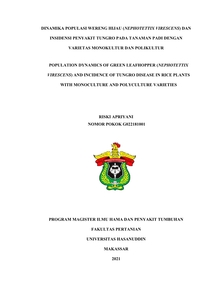Apriyani, Riski (2021) Dinamika Populasi Wereng Hijau (Nephotettix virescens) dan Insidensi Penyakit Tungro pada Tanaman Padi dengan Varietas Monokultur dan Polikultur = Population Dynamics of Green Leafhopper (Nephotettix virescens) and Incidence of Tungro Disease in Rice Plants with Monoculture and Polyculture Varieties. Thesis thesis, Universitas Hasanuddin.
![[thumbnail of Cover]](/16975/1.hassmallThumbnailVersion/G022181001_tesis_cover1.jpg)

G022181001_tesis_cover1.jpg
Download (291kB) | Preview
G022181001_tesis_bab 1-2.pdf
Download (811kB)
G022181001_tesis_dp.pdf
Download (1MB)
G022181001_tesis.pdf
Restricted to Repository staff only
Download (2MB)
Abstract (Abstrak)
RISKI APRIYANI (G022181001). Population Dynamics of Green Leafhopper (Nephotettix virescens) and Incidence of Tungro Disease in Rice Plants with Monoculture and Polyculture Varieties. (Under the supervision of ADE ROSMANA and BAHARUDDIN).
The rice tungro disease (RTD) is one of the major rice diseases that has ability to substantially reduce rice yields. The disease was caused by rice tungro baciliform virus (RTBV) and rice tungro spherical virus (RTSV). Both viruses are transmitted by green leafhoppers, including Nephotettix virescens in a semi-persistent manner. Amongst the rice green leafhoppers species, N. virescens is the most efficient vector of RTD. Integrated pest management based on bioecological management of natural enemies has the potential to create sustainable agroecosystems. The research aimed to determine the effect of varietal monoculture and polyculture cropping patterns on the population dynamic of N. virescens and the incidence of tungro disease, as well as the diversity and development of arthropods. The research was was carried out in a rice farmer’s field in Aka-Akae village, Panca Rijang district, Sidenreng Rappang Regency and Entomopathology Laboratory, Department of Plant Pests dan Diseases, Faculty Of Agriculture, Hasanuddin University. The research was conducted with two cropping patterns, varietal monoculture and varietal polyculture, research used four rice varieties with different ages and their resistance to tungro and green leafhoppers in a completely randomized design. The four varieties used were Ciherang, Inpari 32, Inpari 36 and IR 64. The varieties were planted used Legowo 2:1 row method in two different plots measuring 12 m x 11 m. Each plot was divided into four blocks, each block consisted of four sub-blocks as replications and each replication consisted of two rows of crops representing one type of variety. One block for monoculture and one block for polyculture with a 4 m distance between blocks. The result showed that the incidence of tungro disease in monoculture system were 9.8%, 8.8%, 4.3% and 8.5% on Ciherang, Inpari 32, Inpari 36 and IR 64, respectively. However, the disease incidence occurred in the polyculture system were lower than those in the monoculture system namely : 7.8%, 7.3%, 3.8% and 6.3% on Ciherang, Inpari 32, Inpari 36 and IR 64 about , respectively. The average of green planthopper population density was the optimum at 5 weeks after planting. Polyculture system used rice varieties of Ciherang, Inpari 32, Inpari 36 and IR 64 showed the number of green leafhoppers about 4.8, 2.3, 1.5, and 4 individual per hills. In monoculture system, the rice plant varieties Ciherang, Inpari 32, Inpari 36 and IR 64 varieties has number 6.5, 4.5, 3.3, and 4.5 individual per hills. The application of polyculture system provides an opportunity for the conservation of natural enemies in biological control and very useful controlling pests and diseases of rice plants.
Keywords : Tungro, incidence, monoculture, polyculture, green leafhoppers.
| Item Type: | Thesis (Thesis) |
|---|---|
| Subjects: | Q Science > Q Science (General) |
| Divisions (Program Studi): | Fakultas Pertanian > Ilmu Hama dan Peny. Tumbuhan |
| Depositing User: | S.Sos Rasman - |
| Date Deposited: | 20 Jun 2022 07:55 |
| Last Modified: | 20 Jun 2022 07:55 |
| URI: | http://repository.unhas.ac.id:443/id/eprint/16975 |


